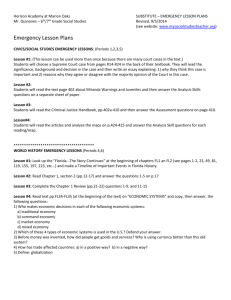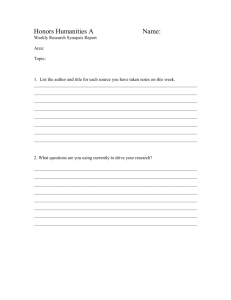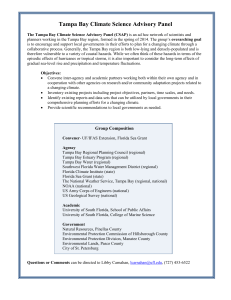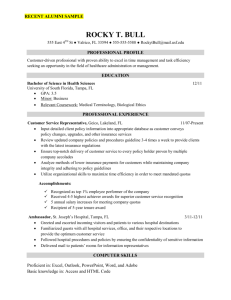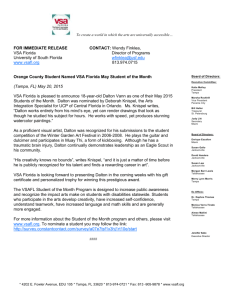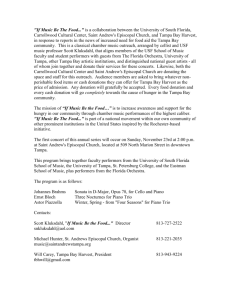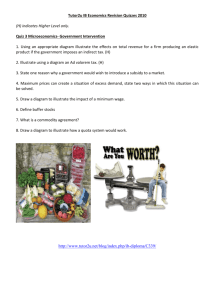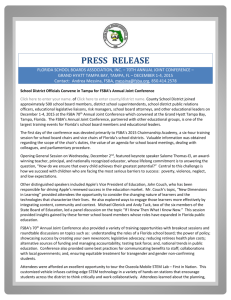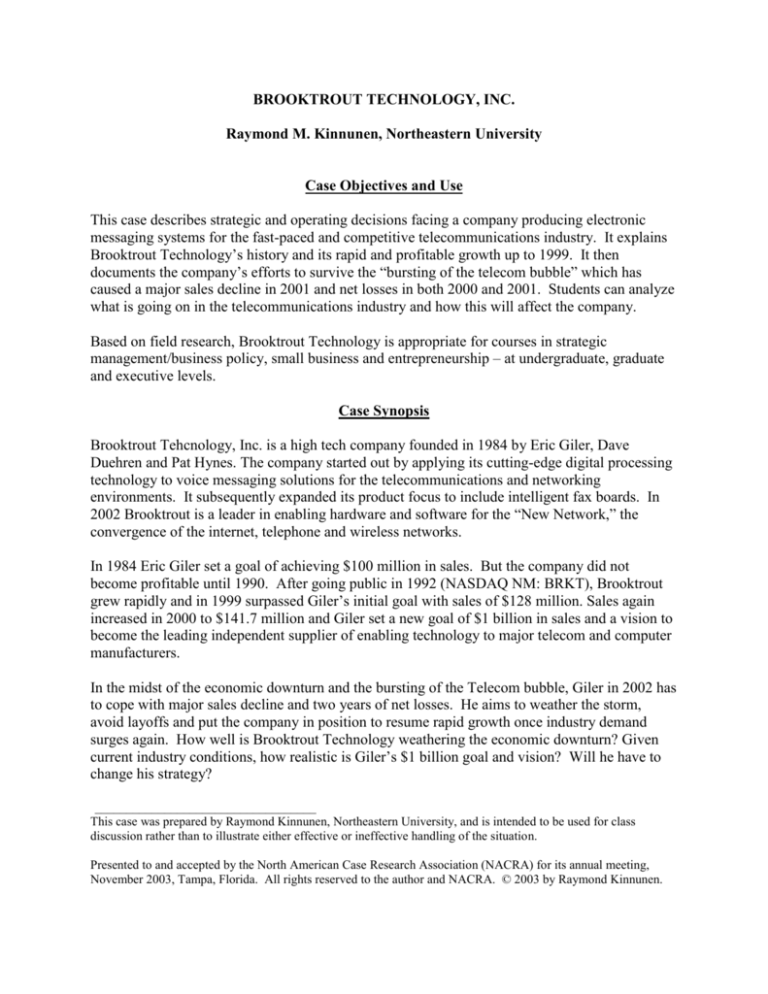
BROOKTROUT TECHNOLOGY, INC.
Raymond M. Kinnunen, Northeastern University
Case Objectives and Use
This case describes strategic and operating decisions facing a company producing electronic
messaging systems for the fast-paced and competitive telecommunications industry. It explains
Brooktrout Technology’s history and its rapid and profitable growth up to 1999. It then
documents the company’s efforts to survive the “bursting of the telecom bubble” which has
caused a major sales decline in 2001 and net losses in both 2000 and 2001. Students can analyze
what is going on in the telecommunications industry and how this will affect the company.
Based on field research, Brooktrout Technology is appropriate for courses in strategic
management/business policy, small business and entrepreneurship – at undergraduate, graduate
and executive levels.
Case Synopsis
Brooktrout Tehcnology, Inc. is a high tech company founded in 1984 by Eric Giler, Dave
Duehren and Pat Hynes. The company started out by applying its cutting-edge digital processing
technology to voice messaging solutions for the telecommunications and networking
environments. It subsequently expanded its product focus to include intelligent fax boards. In
2002 Brooktrout is a leader in enabling hardware and software for the “New Network,” the
convergence of the internet, telephone and wireless networks.
In 1984 Eric Giler set a goal of achieving $100 million in sales. But the company did not
become profitable until 1990. After going public in 1992 (NASDAQ NM: BRKT), Brooktrout
grew rapidly and in 1999 surpassed Giler’s initial goal with sales of $128 million. Sales again
increased in 2000 to $141.7 million and Giler set a new goal of $1 billion in sales and a vision to
become the leading independent supplier of enabling technology to major telecom and computer
manufacturers.
In the midst of the economic downturn and the bursting of the Telecom bubble, Giler in 2002 has
to cope with major sales decline and two years of net losses. He aims to weather the storm,
avoid layoffs and put the company in position to resume rapid growth once industry demand
surges again. How well is Brooktrout Technology weathering the economic downturn? Given
current industry conditions, how realistic is Giler’s $1 billion goal and vision? Will he have to
change his strategy?
___________________________________
This case was prepared by Raymond Kinnunen, Northeastern University, and is intended to be used for class
discussion rather than to illustrate either effective or ineffective handling of the situation.
Presented to and accepted by the North American Case Research Association (NACRA) for its annual meeting,
November 2003, Tampa, Florida. All rights reserved to the author and NACRA. © 2003 by Raymond Kinnunen.
CHARLES RIVER LABORATORIES
Raymond M. Kinnunen, Northeastern University
Case Objectives and Use
The case introduces students to the life science industry that has gone through tremendous
growth even during the “burst” of the tech bubble in Q1 of 2000. The case describes the
company’s history, a private company going public, then bought by Bausch & Lomb, followed
by a management led leverage buyout (LBO), and again going public through a second initial
public offering (IPO). The case pushes students to think about why Charles River Laboratories
(CRL) was growing quickly and successfully. The students should analyze the issues going on
in the pharmaceutical industry and how it has and will play an effect on CRL.
Charles River Laboratories is appropriate for course in strategic management/ business policy,
mergers and acquisitions, or entrepreneurship. It may be used at undergraduate, graduate, or
executive levels.
Case Synopsis
Charles River Laboratories was founded in 1947 by Henry Foster the father of the current CEO
James Foster. The company was developed to offer rodents to medical research and science for
the study, testing, and development of new drugs. CRL supplies services primarily to
pharmaceutical and biotechnology industries. They also supply hospitals, universities, and
government markets. CRL as a company was privately held in 1947, went public in 1968, and
was then bought by Bausch & Lomb in 1984. In 1999 the management led a leverage buyout
and regained control of CRL for one year before taking it public once again. The life sciences
industry has been growing at a phenomenal rate and pharmaceutical and biotechnology
companies have continued to spend tremendous amounts in research and development due to the
extremely large sum of money that it takes to bring a drug through trials and to the market. This
continued growth in spending has directly supported the growth of CRL. With the demand on
the industry to provide the testing support (via mice) CRL had grown through 21 acquisitions
since 1994. CRL was the leader in their market in 2002 holding 46% of the market with the
closest competitor holding only 11%.
Given the recent trend toward consolidation in the industry, and with a lessening number of
quality acquisition candidates, how will CRL continue this growth to keep investors happy?
Venturing out of the core business of supplying research models or expanding those services
were possibilities. Other issues included retaining long-term employees that had recently
become wealthy with the recent IPO.
___________________________________
This case was prepared by Raymond Kinnunen, Northeastern University, and is intended to be used for class
discussion rather than to illustrate either effective or ineffective handling of the situation.
Presented to and accepted by the North American Case Research Association (NACRA) for its annual meeting,
November 2003, Tampa, Florida. All rights reserved to the author and NACRA. © 2003 by Raymond Kinnunen.
CISCO SYSTEMS FALL FROM GRACE
Rebecca Addison & Graham Mitenko
University of Nebraska at Omaha
Case Objectives and Use
This case examines the competition in the computer and networking industry during the
formative years in the industry. The players in the industry tried to position their companies to
fill unique positions, however, as the competition grew fiercer, their original lines of delivery
started to blur and crossover into each other’s products. This combined with obsolescence factor
in leading edge industries (and the subsequent inventory problems) present many different but
interrelated problems to the student. The computer and networking industry was developed
unlike any industry in our history up to that point in time. It is important for the students to
discuss and understand the implications of product development in a fast changing environment.
It is better to develop ones own products (as Bell Labs did) or to acquire new products through
M&A as Cisco attempted to do?
This case is suitable for graduate or upper division undergraduate courses in business strategy,
marketing strategy, production and finance. It would be especially useful in modules dealing
with cost/benefit analysis in relationship to mergers and acquisitions, management strategy and
life cycle problems.
Case Synopsis
The case describes the management decision of Cisco Systems to pursue a mergers and
acquisition approach to adding new products and new product lines as compared to their
competitors, most of whom employed a developmental approach. The challenge during this time
period was to bring new products to the market before your competition, thereby ensuring a
lion’s share of the market for the company. During the mid to late 90’s most companies were
purchasing anything brought to market, without thought of whether it was useful or cost
effective, they were just worried about getting left behind.
Late in 2000 there was a noticeable slow down in new applications and replacement technology,
therefore causing the industry’s cash flow to dry up. Post 2000 the industry became a different
animal, one where spending was not as free flowing as it had been in the previous decade. The
case also looks at and briefly compares the strategies of Cisco’s competitors and shows where
their different products are starting to cross compete.
___________________________________
This case was prepared by Rebecca Addison and Graham Mitenko, University of Nebraska at Omaha, and is
intended to be used for class discussion rather than to illustrate either effective or ineffective handling of the
situation.
Presented to and accepted by the North American Case Research Association (NACRA) for its annual meeting,
November 2003, Tampa, Florida. All rights reserved to the authors and NACRA. © 2003 by Rebecca Addison and
Graham Mitenko.
EAST TENNESSEE FOUNDATION
Sherry L. Williams & Mary Kay Sullivan
Maryville College
Case Objectives and Use
This case is appropriate for an undergraduate or MBA Strategic Management course. It could be
used mid-way through the semester or at semester’s end as a comprehensive overview of
stakeholder analysis, organizational strengths and weaknesses, evaluation of threats and
opportunities in the general environment, evaluation of the competitive environment, and a
determination of what strategy would best give this organization a competitive advantage.
Case Synopsis
In October, 2002, East Tennessee Foundation (ETF), a nonprofit community foundation, faced
some serious challenges. To achieve its purpose of building permanent endowments and
“enriching lives and strengthening communities” in its 24-county service area, ETF was
dependent on the returns from its investment portfolio and from the contributions of donors. The
48% stock market decline since its March 2000, peak, had reduced the value of invested assets
held by the foundation and thus the payout from these investments was down. Donations to ETF
declined significantly from 2000 to 2001. Future economic conditions were a serious concern
Also, community foundations were confronting increased competition from commercial financial
institutions, especially large investment companies . These companies offered charitable giving
programs with lower fees and greater use of technology to serve investors. Banks and colleges
and universities were beginning to enter the field. ETF’s 38-year-old President and CEO, Mike
McClamroch, is a capable, enthusiastic leader who is committed to service to community. He
considered his 11-person team to be very effective, but overworked. The staff has a number of
ambitious initiatives underway in the service area and would like to increase undesignated funds
to better serve needs that they see. The bulk (89.3%, not including supporting organizations) of
ETF’s grants distributed, however, came from donor-advised funds; these are designated by the
donor to go to a particular charitable cause.
ETF’s fundamental strategic problem, although ETF has not defined it as such, is how to
compete in an increasingly crowded field. ETF cannot be the low-cost provider, since
commercial providers can offer lower fees. McClamroch must decide what ETF’s competitive
advantage is or could be.
___________________________________
This case was prepared by Sherry L. Williams and Mary Kay Sullivan, Maryville College, and is intended to be used
for class discussion rather than to illustrate either effective or ineffective handling of the situation.
Presented to and accepted by the North American Case Research Association (NACRA) for its annual meeting,
November 2003, Tampa, Florida. All rights reserved to the authors and NACRA. © 2003 by Sherry L. Williams
and Mary Kay Sullivan.
ELEPHANT WALK THRU
William J. Ritchi & Matthew S. Shell, Florida Gulf Coast University
Ravi Corea & Chandeep Corea, Elephant Walk Thru
Case Objectives and Use
Elephant Walk Thru (EWT) offers students an opportunity to apply environmental scanning
concepts learned in a strategic management class to an international, non-profit organization.
The case provides information regarding EWT’s internal operations as well as selected external
environmental factors providing an opportunity for the student to gather information from
external sources as well.
The teaching note was written for application in an undergraduate Strategic Management course.
This brief case is particularly appropriate for use early in the course during the introduction of
the concept of environmental scanning since the case centers on identifying factors in the
economic, political-legal, technological, and socio-cultural arenas. Ample opportunities exist for
the student to uncover opportunities and threats in each of these domains.
Case Synopsis
The case begins by providing general information relating to the origins of EWT and the
realization by the leadership of the organization that an analysis of the external environment is
needed to enhance future efforts in generating strategy. EWT is an organization in Sri Lanka,
dedicated to melding the economic benefits of tourism and social awareness afforded by
conservation activities. The organization is developing eco-friendly accommodations in a jungle
habitat, allowing upscale adventure-seeking tourists the rare opportunity to observe elephants in
their natural environment. Although the operational details of the project are in place, the
administration of EWT is keenly aware of the fact that more information is needed relating to the
external environmental influences on the project. The case provides information relating to all
four external societal forces (e.g. political-legal, economic, technological, and socio-cultural).
___________________________________
This case was prepared by William J. Ritchie and Matthew S. Shell, Florida Gulf Coast University, and Ravi Corea
and Chandeep Corea, Elephant Walk Thru, and is intended to be used for class discussion rather than to illustrate
either effective or ineffective handling of the situation.
Presented to and accepted by the North American Case Research Association (NACRA) for its annual meeting,
November 2003, Tampa, Florida. All rights reserved to the authors and NACRA. © 2003 by William J. Ritchie,
Matthew S. Shell, Ravi Corea, and Chandeep Corea.
EMANUEL MEDICAL CENTER: CRISIS IN THE HEALTHCARE INDUSTRY
Randall D. Harris, California State University, Stanislaus
Kevin D. Vogt, Emanuel Medical Center
Case Objectives and Use
The case was designed for courses in business policy/strategy and health care management. The
case should provide a good illustration of the significant pressures faced by the management of a
small not-for-profit healthcare facility. The case also attempts to expand the scope of discussion
and illustrate the serious (some would probably argue critical) status of healthcare in the US.
Case Synopsis
Emanuel Medical Center (EMC) located in Turlock, California opened in 1917 and consisted of
150 acute care beds, 145 skilled nursing beds, a 49 bed assisted living facility, emergency
services, ambulatory surgery, an outpatient diagnostic facility, home health, hospice and an
occupational medicine clinic.
As of early 2002, Mr. Robert Moen, President and CEO, was experiencing a number of
challenges. First, there had been negative publicity for EMC following newspaper accounts and a
state investigation of the Haley Eckman incident. Second, the emergency room at Emanuel
Medical Center was experiencing increasing pressure to deliver services in an increasingly
difficult healthcare environment, particularly in light of federal EMTALA legislation. Third,
reimbursements for services from HMOs and government programs had been drastically
reduced, while paperwork and other regulatory burdens had increased. Fourth, for-profit
managed care facilities were making significant incursions into EMC’s service area. Fifth, EMC
was beginning to experience labor shortages, particularly nurses, and this was driving up EMC’s
cost of operations.
The net effect of all of these factors combined put ever-increasing pressure on the profitability of
EMC. EMC’s operating margins had been negative for some time. Moen was beginning to
realize that the pressures being exerted on the hospital by its many stakeholders potentially
threatened its survival as on ongoing operation.
___________________________________
This case was prepared by Randall D. Harris, California State University, Stanislaus, and Kevin D. Vogt, Emanuel
Medical Center, and is intended to be used for class discussion rather than to illustrate either effective or ineffective
handling of the situation.
Presented to and accepted by the North American Case Research Association (NACRA) for its annual meeting,
November 2003, Tampa, Florida. All rights reserved to the authors and NACRA. © 2003 by Randall D. Harris and
Kevin D. Vogt.
HORIZON WIRELESS (A) AND (B)
Julia A. Carson, Donald B. Boldt, & Ira Len Rhodes
East Carolina University
Case Objectives and Use
This case illustrates how a small business is successful in changing strategy and then evaluating
the strategy to fit the needs of its customers. It may be used in assessing entrepreneurial
opportunities or in identifying competitive advantage.
The Horizon Wireless case can be used at the graduate and undergraduate levels in strategy,
management/business policy, small business and entrepreneurship.
Case Synopsis
Horizon Wireless, a small company started in 1997 by M.A. and Alexandria Peterson, was an
independent agent for US Cellular, a wireless services provider. The young couple worked from
their home using an innovative marketing technique that targeted area businesses and the
employees of these businesses. This approach was very successful as they reported increased
revenues for each month they were open for business. By October of 1999, sales and net income
before tax for the year was $545,490 and $257,427.
In order to grow the business and respond to the competitive pressures evolving in the
marketplace, the next logical move for Horizon Wireless was to open a retail store. US Cellular
was also putting pressure on the business to have a retail location or acquire one of theirs. The
strategy had worked well for the business, and some ideas for expanding the sales territory were
also considered as an alternative to a store.
In the A case, M.A. and Alexandria had to decide if they should open a retail store.
The B case was set 15 months later. Horizon Wireless was faced with pressures from US
Cellular to become an exclusive agent, or face reductions in the commissions for each sale as
well as other changes in their business relationship.
___________________________________
This case was prepared by Julia A Carson, Donald B. Boldt and Ira Len Rhodes, East Carolina University, and is
intended to be used for class discussion rather that to illustrate either effective or ineffective handling of the
situation.
Presented to and accepted by the North American Case Research Association (NACRA) for its annual meeting,
November 2003, Tampa, Florida. All rights reserved to the authors and NACRA. © 2003 by Julia A. Carson,
Donald B. Boldt, and Ira Len Rhodes.
KMART: THE STRUGGLE TO REORGANIZE
Bobby Bizzell, University of Houston-Downtown
Robert McGlashan, University of Houston-Clear Lake
Case Objectives and Use
The case allows the students to follow the chronology of Kmart through the maze of
reorganization until it was granted relief from the courts. The objectives of the case are as
follows:
1.
To allow students to see the path to bankruptcy after the decision to enter into this legal
action has been established.
2.
The students should be able to establish a dialogue within the class concerning the roles
played by current management, interim management, suppliers, external funding sources,
and major competitors. The timeliness of the case will generate a need to develop external
information sources to be current in the news of the firm’s potential for success.
3.
The class should also have a lively discussion of the personal and professional agendas of
all of the players in the case.
The case is an excellent vehicle for discussion of reforming the strategy of a firm after
bankruptcy or any other major external forces as presented. As a result the case is highly useful
for a Business Strategy Course, a Legal Environment Course, or a Marketing Management
Course at the undergraduate level.
Case Synopsis
The case follows the actions of Kmart from early 2002 until June 2003 through its struggles to
wind it’s way though the reorganization maze following the filing of bankruptcy proceedings.
The case does not go into the reasons for the firm reaching the position requiring the entry of
Chapter 11 proceedings. These events are chronicled in some depth in a previous case on Kmart
(NACRA Proceedings 2002). Rather this case looks into actions of management, the courts, and
the suppliers and to a lesser extent the major competitors of Kmart.
The case allows the development of a comprehensive strategy for future survival after the firm
has gotten out of the bankruptcy courts. The events, as listed, show how management used the
company for its agendas, how external holding companies and hedge funds played a role in
restructuring the firm’s finances, and how the company looked at itself at the time of the case.
___________________________________
This case was prepared by Bobby Bizzell, University of Houston-Downtown, and Robert McGlashan, University of
Houston-Clear Lake, and is intended to be used for class discussion rather than to illustrate either effective or
ineffective handling of the situation.
Presented to and accepted by the North American Case Research Association (NACRA) for its annual meeting,
November 2003, Tampa, Florida. All rights reserved to the authors and NACRA. © 2003 by Bobby Bizzell and
Robert McGlashan.
LEVI STRAUSS & CO.: FROM RAGS TO RICHES TO RAGS
Barry Allen Gold, Pace University
Case Objectives and Use
The teaching objectives for this case are to: (1) identify the key topics in the management of
organization change; (2) understand the benefit of using a theory to analyze organization change;
(3) know why managers have to learn about complex change processes to manage them
successfully; (4) recognize that knowledge of organization change is important for successful
management careers in the 21st century, and (5) understand the new paradigm of organization
change.
Particular emphasis is on the use of theory to understand organization change and ways to
manage it. In addition, the overall objective is to generate discussion of the various approaches
to change and if, in fact, there is a new paradigm for organization change in the 21st century.
This case is for use by advanced undergraduates and MBA students. A primary reason for
selecting Levi Strauss & Co. is that it is a company that all students are familiar with and can
easily understand. More importantly, Levi Strauss & Co. experienced a type of change that is
common to many types of organizations even those in high tech industries.
Case Synopsis
Levi Strauss & Co is one of the most recognized companies in the world. It has been in business
for 150 years and until recently dominated the global casual apparel market with its signature
denim blue jeans. In 1996 Levi had sales of $7.1 billion but two years later its revenue had
dropped to $6 billion. This dramatic decline in revenues precipitated major changes at the
company including the departure of Robert Hass the family owner of Levis and the appointment
of an outsider to be CEO. Other important changes included a search for new products because
sales of Levi's traditional blue jeans declined in the face of new styles including baggy and
distressed jeans. Among the issues that the company faces as it struggles to regain its market
share is: Has it managed to significantly change? Will it be able to sustain the changes it
instituted?
___________________________________
This case was prepared by Barry Allen Gold, Pace University, and is intended to be used for class discussion rather
than to illustrate either effective or ineffective handling of the situation.
Presented to and accepted by the North American Case Research Association (NACRA) for its annual meeting,
November 2003, Tampa, Florida. All rights reserved to the author and NACRA. © 2003 by Barry Allen Gold.
MOO ROO, LLC
Robert L. Anderson, College of Charleston
Kathleen P. Anderson, BARK, LLC
Case Objectives and Use
This case study about a company that produces expensive ladies’ handbags was developed to
give students the opportunity to create long-term strategy for a relatively new business. Students
should analyze the various options Moo Roo, LLC has and then decide which ones, if not all, are
in the company’s best interest. For example, should the company relocate, should it expand its
product line, can its target market be expanded, can it develop relationships with large
department stores, and should the company go public? Hopefully, students would come to the
conclusion that all of the opportunities suggested in the case are actually necessary for Moo
Roo’s continued growth and profitability.
Case Synopsis
One night Mary Norton, a stay-at-home mother of two girls had a dream about flower covered
handbags. Needing to do something to fill some of the time on her hands, Mary decided to make
the bags she had seen in the dream. Three bags were sold at a spa where her baby sitter worked
and many other customers expressed interest in the bags. In fact, the three bags generated so
many requests from friends and spa customers for similar purses that Mary decided to start a
business. She would design and produce elegant handbags that would complement the evening
attire of smartly attired women. These women became what Mary called her “luxury women.”
Mary’s dream in 1998 of flowered handbags led to the creation of a company that has produced
handbags for celebrities and other women around the world. Moo Roo bags are now available at
more than four hundred boutiques worldwide, and the prospects for continued growth are very
positive. Moo Roo, LLC is expected to generate nearly $10 million of revenue by 2006. To
realize this level of income, the company will expand geographically, add new products to the
existing line, and open more company-owned retail outlets.
___________________________________
This case was prepared by Robert L. Anderson, College of Charleston, and Kathleen P. Anderson, BARK, LLC, and
is intended to be used for class discussion rather than to illustrate either effective or ineffective handling of the
situation.
Presented to and accepted by the North American Case Research Association (NACRA) for its annual meeting,
November 2003, Tampa, Florida. All rights reserved to the authors and NACRA. © 2003 by Robert L. Anderson
and Kathleen P. Anderson.
“MR K” – WHITHER MARION?
Marilyn L. Taylor, University of Missouri at Kansas City
John Altman, Babson College and Ewing Marion Kauffman Foundation
Case Objectives and Use
The case is targeted at Strategic Management courses. It includes insights and data that permit
discussion of the following issues: Organizational Culture, Values, Core Competence,
Entrepreneurship, Delegation and Motivation, Diversification, and Mergers and Acquisitions.
The mergers and acquisitions discussion can be significantly enhanced if the case is coupled with
“The Pharmaceutical Industry in the Late 1980s”.
Case Synopsis
This case focuses on Marion Laboratories in early 1989 as Ewing Marion Kauffman (“Mr. K”),
the founder and Chairman of the Board, prepared to meet with the members of OPs, the Office of
the President. The topic would be review of a report submitted by the “Gang of 19”, a group of
junior executives who had spent a number of months reviewing the firm and analyzing the trends
in its industry.
The case traces the history of Marion Laboratories from its founding in 1950, going public in
1965, the diversification and then divestment program of the 1970s, and the stunning success of
two “blockbuster” drugs, Cardizem and Carafate, in the 1980s.
Marion’s strategy focused on aggressive marketing of drugs that were licensed from other firms,
generally firms from outside the United States. The founder had committed early on to two
major tenets: those who produce share the wealth and treat others as you would want to be
treated. Marion’s culture was well known and the firm was a preferred employer in the Kansas
City area where it was located. Its workforce was loyal, motivated, and productive and its
executive team had been stable for more than a decade.
However, in the late 1980s Marion confronted significant challenges. Carafate was already off
patent and Cardizem’s patent was due to expire in 1992. The cost of developing and bringing a
product to market was escalating. Firms needed international markets to spread the increased
R&D costs. As a result firms were combining. In the face of these and other changes, Marion’s
executive team had to confront what to do.
___________________________________
This case was prepared by Marilyn L. Taylor, University of Missouri at Kansas City, and John Altman, Babson
College, and is intended to be used for class discussion rather than to illustrate either effective or ineffective
handling of the situation.
Presented to and accepted by the North American Case Research Association (NACRA) for its annual meeting,
November 2003, Tampa, Florida. All rights reserved to the authors and NACRA. © 2003 by Marilyn Taylor and
John Altman.
THE PHARMACEUTICAL INDUSTRY CONFRONTS THE 1990S
Marilyn L. Taylor, University of Missouri at Kansas City
Theresa T. Coates, Rensselaer Polytechnic Institute
John Altman, Babson College and Ewing Marion Kauffman Foundation
Case Objectives and Use
This industry note was developed primarily as background for the “Mr. ‘K’ – Whither Marion?”
case for Strategic Management Courses. However, the note can be used on a stand-alone basis.
The note should be used relatively early in an industry analysis course or approximately mid to
late during a course focusing on strategy formulation. Analysis of the information can invoke
several concepts including Porter’s Five Forces Model or Strategic Groups Concept, the
traditional SWOTs analysis or Key Factors for Success, and several international business
concepts relating to international trade or Vernon’s product life cycle concept.
The appendix of the case consists of short summaries of several competitors. The structure
permits several alternatives for the classroom. The professor may a) delete the appendix from
the reading assignment, b) ask the class to consider the appendix as a whole and draw
conclusion, c) Assign each company to an individual student or a student team in preparation for
an in-class M&A exercise. Conducting one or more rounds of negotiation permits opportunity to
see how consolidation among the depicted firms might look at the conclusion of several years.
Case Synopsis
This industry note depicts the pharmaceutical industry at the end of the 1980s. It summarizes
several critical issues confronting the companies. Among the issues were the changing nature of
R&D and marketing strategic choices as well as industry consolidation through M&A activity.
The note provides a brief industry history, overviews the demand trends and current structure on
a worldwide basis, examines several R&D and marketing issues, and reviews briefly the
industry’s consolidation through M&A. The R&D issues include the shortening product life
cycle, issues regarding product development, the alternative of search and development, and the
influence of biotechnology. The marketing issues include the marketing differences between
OTC and ethical drugs and the move toward co-marketing. Industry consolidation had been
taking place through M&A activity. The industry is global in nature which the note reflects, but
the emphasis is primarily on the US. The appendix provides snapshots of: American Home
Products, Bristol-Myers, Gentech, Glaxo, Eli Lilly, Marion Laboratories, Merck, Pfizer,
Schering-Plough, SmithKline-Beckman, Squibb, Upjohn, and Warner-Lambert.
___________________________________
This case was prepared by Marilyn L. Taylor, University of Missouri at Kansas City, Theresa T. Coates, Rensselaer
Polytechnic Institute, and John Altman, Babson College, and is intended to be used for class discussion rather than
to illustrate either effective or ineffective handling of the situation.
Presented to and accepted by the North American Case Research Association (NACRA) for its annual meeting,
November 2003, Tampa, Florida. All rights reserved to the authors and NACRA. © 2003 by Marilyn Taylor,
Theresa Coates, and John Altman.
PIXAR ANIMATION STUDIOS: THE DISNEY ALLIANCE
Shrikkanth Parthasarathy & Ram Subramanian
Grand Valley State University
Case Objectives and Use
Strategic alliances are becoming increasingly vital to a firm’s corporate-level strategy. This case
illustrates the complex nature of an alliance where the terms of the alliance change as the skillsets and resources of the partners evolve. When Pixar was formed, it was an unknown entity with
expertise in a nascent segment of animated motion pictures. It needed the validation through an
alliance with industry behemoth, Disney. However, with the tremendous opening of its 2003
movie, “Finding Nemo,” CEO Steve Jobs has more leverage in the industry. The student is
encouraged to identify strategic choices open to the company and make a recommendation.
The teaching note was written for undergraduate courses in Strategic Management. It fits the
second half of the course, particularly in the module on corporate-level strategy.
Case Synopsis
In June 2003, Pixar Animation Studio’s Chief Executive Officer, Steve Jobs, was faced with a
major decision. His company’s strategic alliance with Disney was due to end in 2005, but Pixar
was allowed to begin negotiations with other companies after the May 2003 release of “Finding
Nemo.” In the current alliance, Pixar and Disney co-financed the production costs of films.
Pixar was responsible for the product and Disney for marketing. After a distribution fee to
Disney was deducted from the film’s proceeds, the two partners share profits equally. While this
arrangement suited Pixar as a start-up, Jobs and the senior management felt that the alliance
contract favored Disney. The decision focus of the case deals with the choices faced by Pixar –
continue the alliance with Disney, seek other alliance partners with more favorable terms, or
vertically integrate into film distribution.
___________________________________
This case was prepared by Shrikkanth Parthasarathy and Ram Subramanian, Grand Valley State University, and is
intended to be used for class discussion rather than to illustrate either effective or ineffective handling of the
situation.
Presented to and accepted by the North American Case Research Association (NACRA) for its annual meeting,
November 2003, Tampa, Florida. All rights reserved to the authors and NACRA. © by Shrikkanth Parthasarathy
and Ram Subramanian.
REBUILDING IBM, 1993-2003:
THE LOU GERSTNER YEARS AND BEYOND
Isaac Cohen, San Jose State University
Case Objective and Use
The case is written in a way that helps students analyze IBM’s turnaround strategy. The first
objective of the case is helping students understand the roots of IBM’s crisis of 1985-1993. The
second objective is having students realize that only a combination of diverse strategic initiatives
brought about IBM’s successful turnaround. The case also gives students an opportunity to
evaluate the role played by IBM’s CEO Gerstner during the turnaround period. As additional
objective of the case is to have students evaluate critically IBM’s current (2002-2003) response
to the industry’s downturn, point out the strengths and weaknesses of such a response, and offer
alternative solutions.
This is a broad case which is suitable for teaching Strategy and/or Business Policy at the
undergraduate (upper division) or graduate levels. The case could also be used effectively for
teaching Technology Management and/or High Technology Management
Case Synopsis
Facing three consecutive years of losses that amounted to $16 billion, IBM managed to
comeback as a revitalized, solidly profitable, globally competitive company. During the nine
year tenure of a single CEO – Louis V. Gerstner – IBM had reinvented itself. The case shows
how Gerstner turned IBM around. It discusses managerial philosophies, organizational
capabilities, and innovative strategies, and deals with marketing, manufacturing, personnel, and
financial issues. It then moves on to the present. Despite IBM’s dramatic comeback, Gerstner’s
successor Samuel Palmisano could not count on the continuing prosperity of IBM because the
technology industry was sliding into the bottom of a recession.
What should Palmisano do? The case, first, lists several challenges Palmisano faced, and
second, it discusses a number of strategic initiatives undertaken by Palmisano during his first
year (2002-2003) as IBM’s CEO.
___________________________________
This case was prepared by Isaac Cohen, San Jose State University, and is intended to be used for class discussion
rather than to illustrate either effective or ineffective handling of the situation.
Presented to and accepted by the North American Case Research Association (NACRA) for its annual meeting,
November 2003, Tampa, Florida. All rights reserved to the author and NACRA. © 2003 by Isaac Cohen.
SMALL BUSINESS DEVELOPMENT CENTER
REGIONAL OFFICE
Dale Varble, Indiana State University
Robert Green, United Arab Emirates University
Case Objectives and Use
This case describes a scenario involving at least perennial problems for most organizations,
distribution of funds for operations and realignment of regions, also a scenario theme the
question of whether a regional director needs to be replaced. A non-profit government network
provides the setting.
The case issues lend themselves to undergraduate or graduate classes. The highest quantitative
analysis requires only spreadsheet skills. Since each formula for funds distribution presented in
the case appears as a table the case easily provides the basis of a stimulating discussion, what
funding formula to use and why without additional quantitative work.
Classes appropriate for the case include sales management (managing sales territories or regions
section), management strategy and management accounting.
Case Synopsis
The regional director desires fund distribution in a sufficient amount to permits the best possible
operation of the region and as important to the director, his employer’s (the SBDC host)
perception of his skills and management of the region office. Ranking of the regional offices
provide insight into the regional office operations and to possible areas of improvement.
The state executive director looks to accomplish the mission and goals of the state SBDC
Network knowing that limited funds are available. Her strategy focuses on developing other
sources of funds and on getting the most out of the government funds available. After review and
discussion one of several funding distribution formulas proposed by regional managers will be
selected as is or refined to distribute funds. The formula selection process depends heavily on
consensus thus regional managers must be familiar with and convincing to persuade others to
select a particular formula. Case decisions include the selection of a funds distribution formula,
whether to support re-organization of the regions and for one regional manager what to do to
improve job performance in the eyes of his SBDC host.
___________________________________
This case was prepared by Dale Varble, Indiana State University, and Robert Green, United Arab Emirates
University, and is intended to be used for class discussion rather than to illustrate either effective or ineffective
handling of the situation.
Presented to and accepted by the North American Case Research Association (NACRA) for its annual meeting,
November 2003, Tampa, Florida. All rights reserved to the authors and NACRA. © 2003 by Dale Varble and
Robert Green.
THE DILEMMA OF IDEALISM OR BUSINESS VALUATION:
LION TAIL OR ANT HEAD?
Fábio Frezatti, University of São Paulo, Brazil
Case Objectives and Use
The main objective of the case is to analyse a valuation case of a small Internet organization and
to identify the consequences of the decision for the current owners. The decision to be made has
the following main options: (i) to close the entity; (ii) to increase the investment; (iii) to sell or
merge (with various implications in terms of cash flow, power, motivation, and people’s projects
of live). For how much and how it should be done is part of the process addressed in this case.
However, more than computing figures, the case focuses on what to do with the information. It is
recommended to the following disciplines for accounting undergraduate students:
1.
2.
3.
4.
Finance: when the students have some prior background in forecast, result projections, cash
flow and the deal is to integrate numeric with decision process;
Strategy: when it is required to make the group identify numeric information need for the
decision process;
Behavior: when it is required to emphasise the objective focus of the negotiation; e
General overview of selling/purchase activities, specifically referring on intangibles assets.
Case Synopsis
Dilemmas are a sensitive part of the decision process and, in the most of the case studies, the
identification of the “correct answer” is not paramount for success. The decision process requires
not only objectivity, but also sensitivity about figures projections and choices among the options
and partnerships available. Because it was developed for large companies and primarily tangible
assets, the traditional conceptual framework is not always applicable to small organizations and
Internet organizations. wwww.clickfilhos.com.br is a Brazilian experience of an Internet social
project involving intangible assets and a limited funding approach. A combination of figures and
“feeling” is essential to cope with this kind of activity in order to attain a proper understanding of
the decision process. For some authors, this kind of activity is much more art than science.
___________________________________
This case was prepared by Fábio Frezatti, University of São Paulo, Brazil, and is intended to be used for class
discussion rather than to illustrate either effective or ineffective handling of the situation.
Presented to and accepted by the North American Case Research Association (NACRA) for its annual meeting,
November 2003, Tampa, Florida. All rights reserved to the author and NACRA. © 2003 by Fábio Frezatti.
THE LITTLE BANK
Ira Len Rhodes & Donald B. Boldt
East Carolina University
Case Objectives and Use
This case illustrates the external threats and opportunities that developed in the rapidly changing
banking industry, and may be used in identifying a specific market segment and crafting an
effective strategy to successfully compete in a niche market.
The little bank case can be used at the graduate and undergraduate levels in strategy
management/business policy, small business, and entrepreneurship.
Case Synopsis
Seventy-eight year old C. Felix Harvey III was the principal owner of L. Harvey and Sons, a 125
year old family business that served Eastern North Carolina with sales of over $148 million in
1993. Since joining the family business in 1946, Harvey grew the company to include John
Deere dealerships, savings and loans, a land clearing company, and one of the largest trucking
firms on the East Coast. Harvey also served on boards for many companies, five of which were
listed on the New York Stock Exchange. It was during Harvey’s tenure on the board of North
Carolina National Bank (NCNB) that Hugh McColl, who directed the development of NCNB
into NationsBank and then the merger with Bank of America, was hired.
In November of 1998 Harvey co-founded the little bank in Kinston, North Carolina, a small
Eastern North Carolina community. Harvey and his partners felt that a booming economy along
with deregulation had created the right time to enter the banking business. In addition, the recent
trend of mergers and mega-mergers between banks or between banks and other financial
institutions left an attractive market for a small community bank. Harvey was very successful in
raising $14 million in capital in just sixty days and opening the little bank in record time. The
little bank was also very successful in attracting deposits in its first six months of operation.
After its second quarter of business, the little bank began to focus its attention on loans. Don
Carpenter, the little bank’s president, started considering several alternatives. Although
Carpenter was considering consumer and credit card loans, the most attractive option was to
open another branch. To that end, Carpenter hired an MBA student from East Carolina
University to prepare a market research and competitive analysis report of other nearby cities.
The action issue is: Where should the new branch be located to expand the little bank’s deposit
and loan base?
___________________________________
This case was prepared by Ira Len Rhodes and Donald B. Boldt, East Carolina University, and is intended to be used
for class discussion rather that to illustrate either effective or ineffective handling of the situation.
Presented to and accepted by the North American Case Research Association (NACRA) for its annual meeting,
November 2003, Tampa Florida. All rights reserved to the authors and NACRA. © 2003 by Ira Len Rhodes and
Donald B. Boldt.
VODAFONE NEW ZEALAND
Kate Kearins, Auckland University of Technology
Stephen Bowden, University of Waikato
Case Objectives and Use
This comprehensive strategy case provides students data to analyse the major functional areas of
a new generation company, and focus on resources and capabilities and competitive dynamics in
a challenging industry context – as a basis for formulating a strategy that will maintain growth
momentum in the ‘consumer’ market as well as winning a greater share of the business market.
Case Synopsis
Vodafone Group, UK parent of Vodafone New Zealand, recently announced the largest loss in
European corporate history largely due to massive asset writedowns. So, in August 2002, was
Tim Miles, Managing Director of Vodafone NZ, fretting over the global company’s future? No!
Vodafone NZ had been tremendously successful since entering the New Zealand cellular
telecommunications market in 1998, currently had 46% market share, and was number one in
mobile revenue. Up against former government monopoly, market incumbent and New Zealand
stockmarket heavyweight, Telecom NZ - and facing new entrants – Vodafone NZ had
advantages of a global presence and strong brand. Vodafone NZ was notorious for its internal
culture and the connected image it portrayed to customers. Vodafone NZ was a ‘zesty’,
‘intrepid’, ‘hot’, ‘simple and clever’ ‘cool tribe’. Those kind of images, while great for the
wireless generation, had to date been less effective for the business/corporate market, where
there existed a real opportunity to grow Vodafone NZ’s market share.
Relatedly, while mobile voice services were the core of current mobile services, data services
were predicted to be the big growth area, with business likely to be the biggest data users. The
question for Tim Miles and his executive team was how could Vodafone NZ best grow its
‘business’ business – while retaining current customers and continuing to attract the allimportant next generation of mobile users? Telecom NZ had the biggest share of the business
market and advantages of complementarity in its fixed line business. Vodafone NZ was only in
mobile, competition between telcos was heating up, and it needed to convince hard-nosed
businesses that they wanted more wireless solutions now to justify previous investment decisions
in mobile spectrum rights. Could Vodafone NZ make its quirky values and brand image work in
the business/corporate market, or would it have to try something else? What?
___________________________________
This case was prepared by Kate Kearins, Auckland University of Technology, and Stephen Bowden, University of
Waikato, and is intended to be used for class discussion rather than to illustrate either effective or ineffective
handling of the situation.
Presented to and accepted by the North American Case Research Association (NACRA) for its annual meeting,
November 2003, Tampa, Florida. All rights reserved to the authors and NACRA. © 2003 by Kate Kearins and
Stephen Bowden.
THE ZONE REORGANIZATION:
DEVELOPING A STRATEGY FOR MANAGING CHANGE
Stuart Rosenberg, Dowling College
Case Objectives and Use
This case demonstrates the importance of developing an appropriate strategy for change
management in a multisite organization. The objective of the manager is to decide upon the
strategy that will best accommodate the change. The student is expected to understand the
drivers of the change and to evaluate the alternative plans of action to determine the most
suitable strategy for managing the change. The conflict that exists between the business needs of
the firm and the personal needs of the employees make the decision a sensitive one, and, given
the uncertainty in the work environment in connection with the change, effective communication
with staff is critical.
The teaching note was written for undergraduate or graduate courses in Strategic Management.
Because much of its focus is on the implementation of a corporate strategy that could be
problematic for employees, the case study can also be useful in undergraduate or graduate
courses in Organization Behavior.
Case Synopsis
Christine Brooks is the regional claims manager for a large insurance company that is scheduled
to undergo a zone reorganization. Corporate management has concluded that restructuring the
company is necessary in order to be more competitive in a business environment impacted by
recent deregulation as well as a weak economy. Christine is responsible for implementing the
reorganization of the claims offices within her region, which will involve consolidating the
employees from four offices into one office. Many of the first line managers in the various
claims offices have informally indicated to Christine that morale among their employees has
deteriorated since the announcement of the restructuring. She decides to ask her managers to
complete an anonymous survey and then to bring them together for an all-day meeting intended
to determine the operating strategy to be used to facilitate the zone reorganization.
___________________________________
This case was prepared by Stuart Rosenberg, Dowling College, and is intended to be used for class discussion rather
than to illustrate either effective or ineffective handling of the situation.
Presented to and accepted by the North American Case Research Association (NACRA) for its annual meeting,
November 2003, Tampa, Florida. All rights reserved to the author and NACRA. © 2003 by Stuart Rosenberg.

